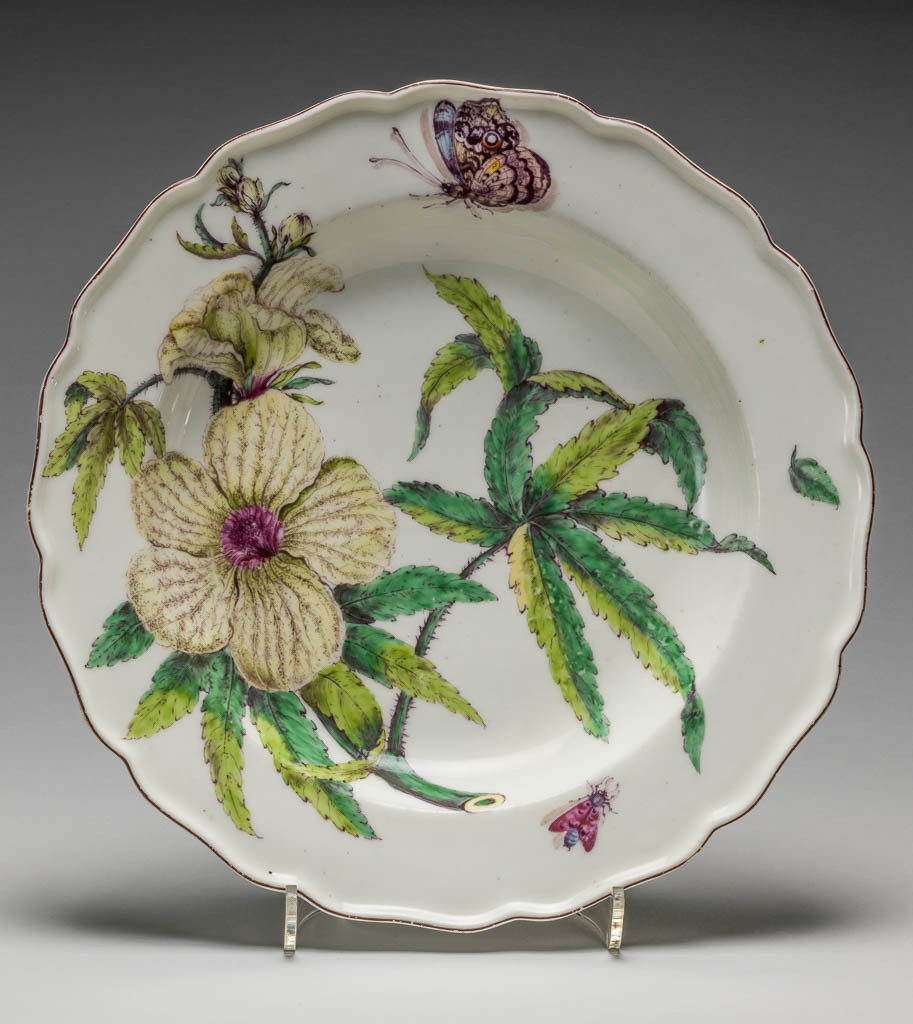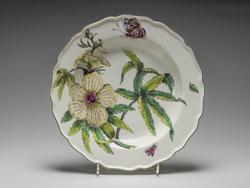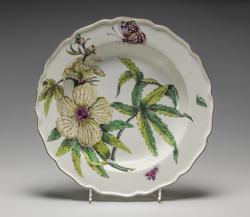Current Location: Gallery 26 (Lower Marlay)
Maker(s)
Factory:
Chelsea Porcelain Manufactory
Entities
Categories
Description
Soft-paste porcelain plate, decorated with botanical flowers and insects in polychrome onglaze enamels.
Soft-paste porcelain, moulded, glazed, and painted in pale blue, green, yellowish-green, pale yellow, pale and dark purple, dark reddish-brown, and black enamels. The glaze on the reverse has several black speckles, and there are three spur marks within the footring.The plate is circular with a wavy edge, wide rim, and deep well with curved sides, standing on a footring. Placed asymetrically on the viewer's left, are the leaves, an open flower, and buds of the Ketmia Indica (Indian Hemp) with a butterfly hovering above on the rim, and a smaller insect below. The edge is outlined in dark reddish borwn.
Notes
History note: Unknown before Mrs W.D. (Frances Louisa) Dickson
Legal notes
Given by Mrs Francis L. Dickson
Measurements and weight
Diameter: 24 cm
Height: 3.7 cm
Acquisition and important dates
Method of acquisition: Given
(1950-09)
by
Dickson, W. D. (Frances Louisa), Mrs
Dating
18th Century, Mid
George II
Red anchor period (1752-1756)
Circa
1752
CE
-
1756
CE
Note
Chelsea tableware with botanical designs were described as being decorated with 'India Plants' referring to the West Indies, rather than as was more usual Oriental Indies, although many of the plants featured did not come from those islands. For example, on the second day of the 1755 Sale Catalogue, lot 36 comprised 'Twelve very fine desart plates, India plants, all different'. The designs were based on plants which appeared in several illustrated botanical books. The design on this plate was derived from Georg Dionysius Ehret (1708-70), 'Plantae et Papiliones Rariores', 1748-62, pl. VI, where the Ketmia or Indian Hemp flowers and foliage are depicted with Iris and Alsine, and a smaller illustration shows the whole plant in a pot. The plant is described below as 'Ketmia Indica foliis digitatis flore magna sulphureo, umbone altro purpureo, pediculis foliorum spinosis. Three drawings by Ehret of Ketmia Indica are dated 1742.
School or Style
Rococo
Components of the work
Decoration
composed of
enamels
( pale blue, green, yellowish-green, pale yellow, pale and dark purple, dark reddish-brown, and black enamels)
Materials used in production
possibly containing tin-oxide
Glaze
Soft-paste porcelain
Techniques used in production
Moulding
: Soft-paste porcelain, moulded, glazed,
Glazing (coating)
Inscription or legends present
Inscription present: an anchor over 4
- Text: an anchor/4
- Location: On the base
- Method of creation: Painted in red enamel
- Type: Factory mark
Inscription present: rectangular white paper label with the inscription written between two black printed horizontal lines
- Text: Hybiscus
- Location: On base
- Method of creation: Hand-written in pencil
- Type: Label
Inscription present: very small rectangular white paper stick-on label
- Text: 1930/4
- Location: On base near footring
- Method of creation: Hand-written in black ink
- Type: Label
References and bibliographic entries
Related exhibitions
Identification numbers
Accession number: C.91-1950
Primary reference Number: 131404
Stable URI
Audit data
Created: Saturday 6 August 2011
Updated: Monday 25 March 2024
Last processed: Tuesday 13 May 2025
Associated departments & institutions
Owner or interested party:
The Fitzwilliam Museum
Associated department:
Applied Arts

 IIIF Manifest
IIIF Manifest






